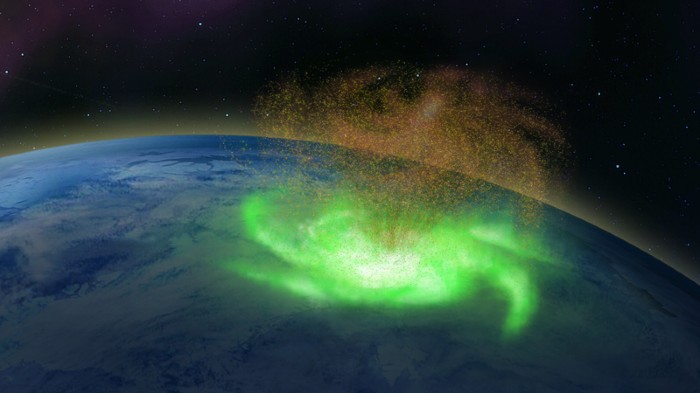'Space hurricane' caught raging over North Pole during one of the sun's quietest days
A rare "space hurricane" that swirled over Earth's North Pole in 2014 caused intense space weather effects despite unusually quiet solar conditions, a new study reports.

A rare hurricane that raged high above Earth's North Pole in 2014 packed a surprising punch, and may be even stranger than scientists first thought.
The phenomenon, called a "space hurricane," unleashed intense space weather effects normally seen only during major solar storms, despite the sun being unusually quiet that day, according to a new study.
The report offers the first detailed analysis of the nearly eight-hour tempest, which was first known to have occurred on Aug. 20, 2014. Researchers found that it disrupted GPS signals, shook Earth's magnetic field, and packed the upper atmosphere with extra electrons.
"Our study demonstrates that space hurricanes can trigger significant space weather effects, even during what are generally viewed as extremely quiet periods," study lead author Sheng Lu, who is a scientist at the Institute of Space Sciences at Shandong University in China, and his colleagues wrote in the study, which was published in July in the journal Space Weather.
A stealth storm in space
The 2014 space hurricane, first formally described in 2021, was initially detected by the U.S. military's DMSP F17 satellite, which monitors space weather conditions. Minutes later, the European Space Agency's Swarm B satellite flew through a nearby region, gathering key data that confirmed the storm's structure and size, according to the new study.
The hurricane measured more than 620 miles (1,000 kilometers) in diameter and swirled over the polar cap, a high-latitude zone where Earth's magnetic field funnels solar and cosmic particles into the atmosphere. Like its atmospheric namesake, the space hurricane featured a calm center, or "eye," and swirling spiral arms that were clearly visible in the satellite observations. But instead of howling winds and torrential rain, it flung streams of high-energy electrons into the upper atmosphere.
Although they're invisible to the naked eye, space hurricanes can be detected by satellites and sensitive instruments on the ground, thanks to the glowing, spiral-shaped auroras these storms produce.
Get the world’s most fascinating discoveries delivered straight to your inbox.
In this case, data from multiple spacecraft and geomagnetic stations in Greenland and the Canadian Arctic showed GPS signal disruptions, magnetic-field fluctuations and elevated electron densities — all of which can interfere with satellite navigation, communications and radio transmission systems, the scientists explained in the study.
The wealth of measurements allowed researchers to reconstruct the storm in unprecedented detail, something that hadn’t been possible in earlier decades. Since the late 1960s, researchers had suspected space hurricanes might exist, until now they had lacked the tools to confirm these storms.
"In those days, even though there were a lot of spacecraft up in space, they did not have the kind of instrumentation that you would need to really understand what was taking place," John Foster, a research scientist at MIT's Haystack Observatory who recalled seeing a similar event more than 50 years ago, told Eos. "What makes this event really special is the wide variety of instrumentation that was available in space to look at the characteristics of this phenomenon."
Initially considered a rare anomaly, the 2014 space hurricane has since helped open the door to further discoveries. Recent follow-up studies have revealed that these storms are not only more frequent than previously thought but also occur in both hemispheres — typically during the summer months and possibly up to 10 times a year.
Despite potential disruptions to satellites and pieces of trash in orbit, space hurricanes don't pose a danger to life on Earth.

Sharmila Kuthunur is an independent space journalist based in Bengaluru, India. Her work has also appeared in Scientific American, Science, Astronomy and Space.com, among other publications. She holds a master's degree in journalism from Northeastern University in Boston. Follow her on BlueSky @skuthunur.bsky.social
You must confirm your public display name before commenting
Please logout and then login again, you will then be prompted to enter your display name.


